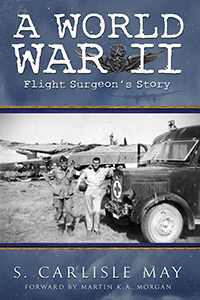A Flight Surgeon's Story - First Three Pages
“Hey, Doc! Inbound. Causalities.” The medical aide yelled as he loped by the tent door. “The pilot radioed. Shots to the fuselage. Three injured. One engine out.” Flight Surgeon Lamb Myhr, snatched up the medical bag he kept supplied for such occasions.
The June 1943, heat in the North African desert hit Lamb like a punch to the face as he pushed out the door. Layers of heat shimmered along the horizon. As he climbed into the jeep, the aide stomped the gas and rocked Lamb back into the seat. They sped past the squadron tents dispersed among the rolling sand dunes until they reached the lone flat area the 314th Carrier Group maintained as an airstrip.
A hum grew into a roar as the first of the C-47s came into view. One plane flew outside the standard tight formation, its wing dropping to the right. After that plane, another aircraft also listed with a small trail of dark smoke trailing out behind. The plane no longer in formation landed and quickly taxied out of the way. Undamaged planes circled above, letting the injured ones land first.
The smoking airplane touched down, rolled a few yards before its nose hit the runaway, then skidded sideways. A wing bounced off the ground, bringing the plane to a jerking halt. The right engine burst into flames.
Speeding forward, the aide drove the jeep as close to the plane as possible, arriving just before the ambulance. The heat from the fire drove the already over-a-hundred-degrees desert temperature even higher. The metal skin of the craft ceased rattling as the jeep to a halt and Lamb jumped out. Asbestos–clad fire crew bounded off a large truck and hustled to smother the flames with foam. Others pushed closer in hopes of saving the flight crew.
“Doc, it’s Rogers. He has burns to his hands and feet,” a crewman yelled before disappearing into the interior of the plane. A minute later the crewmember reappeared, supporting Rogers with the help of another man. Every crewman worked quickly to carry the injured out onto the wing. The aide handed up a litter. Rogers was placed on the litter and carefully lowered him down. Through the haze of black rolling smoke caught in the unceasing wind it was difficult to see or breathe.
“Anyone else?” Lamb called.
The flight crew members shot Lamb a grim look. “Simmons and Rich didn’t make it.” His level voice contrasted with the dark emotion reflected in his eyes. “Others are behind me. Mac has a cut. Nothing serious.”
“Let’s get Rogers on the jeep and away from the plane,” Lamb told his aide and men ran to help. Lamb knew there was a high probability of pilots and co-pilots burning to death during landings but that knowledge never made the experience any more palpable.
Lamb had no time to worry about what was happening around him. He had a patient to consider and he needed to stabilize Rogers for transport to the hospital.
With the help of the aide, Lamb secured Rogers in the ambulance. “You’ll be fine, Rogers. Hang in there.” Lamb said as he gave the airman morphine.
Turning to another aide Lamb ordered, “Check the other man. See that the bleeding is controlled and bring him to the dispensary.” Lamb climbed into the ambulance. He and his aide sped away from the burning plane with Rogers.
At the dispensary, Lamb cut away the burned fabric of Roger’s flight suit and applied carbolic acid and phenol and covered it with gauze impregnated with Vaseline which worked like a local anesthetics over the red, angry skin. It was a slow process but effective. This helped relieve pain and hyperemia. This method of burn care had recently become standard procedure.
Rogers moaned.
Lamb waved his hand over Rogers to keep the flies at bay. “We’ll get you on a plane and out of here as soon as possible.”
Crashed and burning planes were a regular occurrence and a dangerous part of flying for the aircrews of the United States Army Air Forces during World War II. Scenes like this one would occur numerous times before the twenty-five-year old doctor returned to Tennessee at the war’s end.

